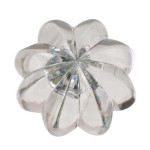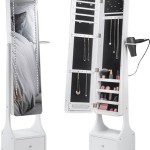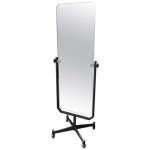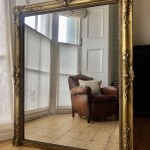Leaning Wall Mirrors: A Comprehensive Guide
Leaning wall mirrors, also known as floor mirrors, offer a versatile and stylish alternative to traditional wall-mounted mirrors. Their freestanding nature allows for easy relocation and adaptability to changing room layouts and design preferences. This guide will explore the various aspects of leaning wall mirrors, from their benefits and design considerations to practical tips on selection, placement, and maintenance.
One of the key advantages of leaning wall mirrors is their flexibility. Unlike wall-mounted mirrors, they do not require complex installation procedures or permanent fixtures. This makes them an ideal choice for renters or individuals who prefer the freedom to rearrange their living spaces frequently. Simply lean the mirror against a wall and adjust its angle to achieve the desired reflection and aesthetic effect.
Leaning wall mirrors contribute significantly to a room's visual appeal. They can create an illusion of spaciousness, especially in smaller rooms or hallways. A strategically placed leaning mirror can reflect natural light, brightening up a dim corner and enhancing the overall ambiance. They also serve as a decorative element, reflecting the surrounding decor and adding a touch of elegance and style.
A wide variety of leaning wall mirrors are available to suit diverse tastes and interior design styles. Frames can range from simple and minimalist designs to ornate and elaborate ones. Common frame materials include wood, metal, and plastic, each offering a unique aesthetic. Wood frames provide a classic and warm touch, while metal frames offer a modern and sleek look. Plastic frames are often a more budget-friendly option.
Mirror shapes and sizes also vary considerably. Full-length mirrors are popular choices for bedrooms and dressing areas, providing a complete view for outfit coordination. Smaller, rectangular or square mirrors can be used as accent pieces in living rooms or hallways. Round or oval mirrors offer a softer, more organic feel. Consider the existing furniture and décor when choosing a shape and size that harmonizes with the overall room design.
The placement of a leaning wall mirror is crucial for maximizing its functionality and aesthetic impact. In smaller rooms, placing the mirror opposite a window can amplify natural light and create a sense of depth. In a bedroom, positioning the mirror near a closet or dressing area provides a practical solution for outfit checks. In a living room, a leaning mirror can be used to reflect a focal point, such as a fireplace or a piece of artwork, enhancing its visual prominence.
Safety is a critical consideration when using leaning wall mirrors, especially in households with children or pets. Ensure the mirror is leaned against a stable wall and angled appropriately to prevent tipping. Consider using wall anchors or other securing mechanisms for added stability. Regularly inspect the mirror for any signs of damage or instability.
Maintaining a leaning wall mirror is relatively straightforward. Regular dusting with a soft cloth is usually sufficient to keep the mirror clean and free from smudges. For more stubborn marks, a mild glass cleaner can be used. Avoid using abrasive cleaners or harsh chemicals, which can damage the mirror surface or the frame.
Choosing the right leaning wall mirror involves careful consideration of several factors. First, determine the primary purpose of the mirror. Is it for practical use, such as checking outfits, or primarily for decorative purposes? Next, consider the size and layout of the room where the mirror will be placed. A large mirror can overwhelm a small space, while a small mirror might get lost in a larger room. Finally, consider the existing décor and choose a mirror style that complements the overall aesthetic.
Budget is another important factor to consider. Leaning wall mirrors are available at a wide range of price points, depending on the size, frame material, and design. Set a budget beforehand to narrow down the options and avoid overspending.
Beyond the practical and aesthetic benefits, leaning wall mirrors can also contribute to a sense of well-being. They can help create a brighter and more inviting atmosphere in a room, promoting a positive and uplifting mood. The ability to easily adjust and reposition the mirror also provides a sense of control and personalization over one's living space.
By carefully considering the various aspects discussed in this guide, individuals can select and place a leaning wall mirror that enhances both the functionality and aesthetics of their living space. From creating an illusion of spaciousness to reflecting natural light and adding a touch of style, leaning wall mirrors offer a versatile and practical solution for any interior design project.

How To Build Large Floor Leaner Mirror Sawdust 2 Stitches

How To Secure A Leaning Mirror The Wall Diy Playbook

Herringbone Floor Mirror Full Length Decorative Rustic Wood Frame Leaning Shown In Special Walnut Available 20 Colors

Build A Beautiful Leaning Floor Mirror Designed Decor

Ogcau Floor Mirror Full Length Standing Hanging Or Leaning Against Wall Arched Top For In Bedroom Mounted Living Room

Full Length Wood Wall Leaning Ladder Mirror N A Oak Clear Com

Leaning Pictures And Mirrors The Easy Alternative To Hanging Art

How To Anchor A Leaning Mirror The Wall Loving Here

Best Choice S 65x22in Full Length Mirror Rectangular Beveled Wall Hanging Leaning Floor Target

Hundreds Of Custom Leaning Mirrors Standing Floor








